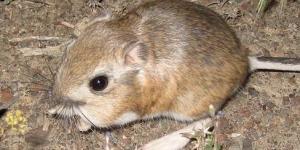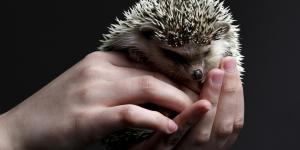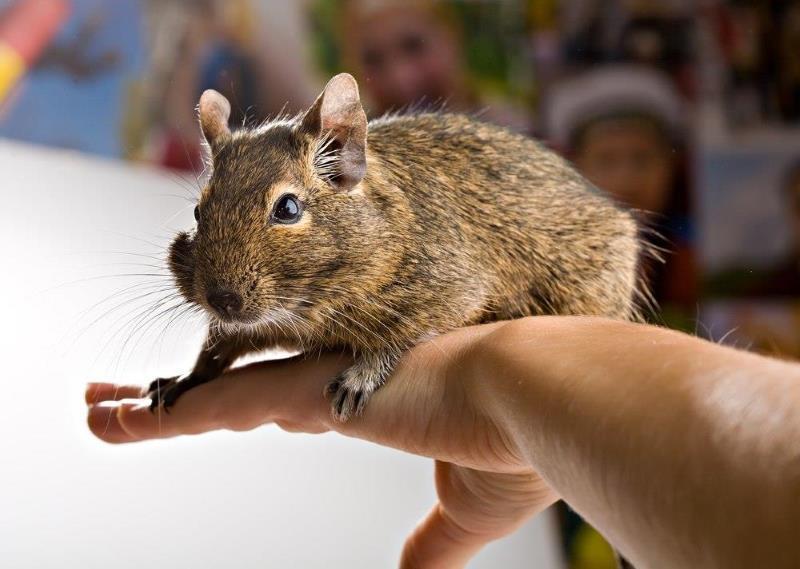Degu as Pets - Caring for the Common Degu


There are many animals in this world which look adorable and instantly appeal as a pet. Unfortunately, due to their temperament, sexual maturity, basic care needs and conservation status, many of these animals are unsuitable for the majority of domestic environments. Good news then if you are thinking about adopting a degu as a pet. While these animals are considered exotic, they are also predisposed to company and can get on very well with human companions.
However, no animal should be adopted into a family without due consideration and the degu is no exception. This is why AnimalWised brings you this guide on the degu as pets. We provide some information on the background of the common degu, we describe their character and we show you everything you need to know about caring for this wonderful rodents.
Physical characteristics of the degu
The common degu (Octodon degus) is a small sized rodent with a similar appearance to the domestic rat (Rattus norvegicus). However, their lifespan is generally much longer than the rat and they can live to around 10 years of age if well-cared for. They are brown in color with a somewhat lighter belly. They have a long scaly tail which ends in a tuft of hair. Special care needs to be taken with this tail as it can easily be pulled off, something very painful for the animal. They tend to shed towards the end of spring.
Their eyes are small and black. Their ears are large and can become dirty relatively easily which leads us to an important facet of the degu. They are very social animals and are known for caring for and grooming each other. Degu cannot reach their ears properly, do they need a friend to do it for them. It is possible to keep a single degu as a pet, but it is not recommended.
While it might seem like a sign of illness, the degu have teeth with a bright orange color on the front. If a color change does occur, it is likely due to a dental disorder. Dental health is very important as cheek teeth malocclusion is positively correlated to mortality rates[1]. Male degus are more likely to develop dental problems than females. Similar to rabbits, their teeth do not stop growing so they need to have something to gnaw on to file them down.
They have ‘fingers’ on both front and rear feet. Their front paws have a nailed digit which helps them to hold food as they graze on it and eat. While the degu is not yet as popular a pet as other small rodents such as rats and hamsters, there is one particular element which makes them great pets for humans. Degu are diurnal animals, meaning they are alert and awake during the day. This is unlike hamsters which are nocturnal. It means you can share more quality time with a pet like the common degu because you do not disturb their circadian rhythm.

Origin of the degu
The degu is originally from Chile. There they inhabited the slopes of the Andes, from the foothills to high altitudes. They live in small family groups and are very sociable. The care they provide for each other doesn't stop at the aforementioned grooming practices. It has been observed that female degu will nurse each other's young[2]. In the wild, they will burrow together and even communicate in such as way as to coordinate their efforts.
Their burrows are interconnected and, as you would expect with such sociable creatures, degus have intricate communication patterns. They make different sounds for different purposes, but they need to grow up together and learn what each means. To feed, degus go outside the burrows and scavenge. They are herbivores and feed mainly on greenery and plant bark, but will also consume seeds and some vegetables.
Character of the degu
As we are trying to stress, degus are extremely sociable animals. They love to play together and should get along well even in small spaces. They stay together to conserve heat and will administer to each other's needs. This is why it is so important not to have a single degu, but to adopt them in at least a pair, if not more. If a degu is forced to live on their own, even if we provide them with our own socialization, they will develop stress symptoms and can even exhibit aggressive behavior toward their human companions. They will even mutilate themselves and can develop life threatening health problems. For these reasons, single living degu will also have a decreased life expectancy.
Communication consist of a range of aural and corporeal language. While we will not be able to recognize all of these signals, it is important we pay attention to our degu to troubleshoot any problems. Signs to pay attention to include:
- Bristled fur: this is a warning sign and it appears when something has frightened or threatened them. It is common for this to occur during the first few days of a degu adjusting to their new home.
- Hiding behind their tail: adopting a position where they hold their tails in front of them is a sign of either submissive or defensive behavior. Either way it can be a sign there is something stressful occurring.
- Running, jumping or rolling: these are generally happy behaviors which show they are happy and healthy.
- Sleeping together: if you have several degus, it is normal for them to sleep together, even sleeping on top of one another.
- Pushing: occasionally, you might see two degu standing in an upright position and pushing each other. This is a method of communicating and play fighting. Some degu might fight for dominance, but it will only be a problem if they start injuring each other.
- Clicking teeth: when a degu does this, they are showing aggressive behavior, usually because something has bothered them.
- Trill: this sound is most often used with a mother degu and her pups, The exact reason for its use is not known, but it may be simply used to call and wrangle them or notify them for feeding.
- Grunts: grunting in degus is usually a sign of danger and that you need to give them space.
- Squeaks: there are various low and high pitched squeaks, but they tend to be used for general communication. The intonation will be important in understanding their well-being.
Feeding a pet degu
We need to feed degus a diet which is specifically designed for them. It is not easy to find degu specific feed, even in exotic pet stores. Thankfully, their nutritional needs are similar to those of rabbits and chinchilla. In the wild, degu feed on hers, grasses, flowers, grains and vegetables. Their diet should be supplemented with vegetables, leafy greens and flowers, including carrots, turnip leaves, beet leaves, Swiss chard, endive, celery, lettuce, spinach, clover, dandelion and wild vegetables. However, cabbage and tubers are toxic to degu, so do not feed them. To supplement their diet, they will need to be offered hay.
As treats, we can offer them nuts and seeds, but only sporadically. We should never give sugar to a degu. They have a tendency toward diabetes which is why scientists have often studied them for research purposes. While you need to ensure they are fed, do not overfeed your degu. If you see they start hiding food, then it is likely this is happening. It may seem unpleasant, but it is normal and healthy for them to eat their own feces (coprophagy). It helps them to absorb vitamins from the B and K groups. However, as degu eat their feces seasonally due to availability of food[3], you should consider if they are getting all the nutrients they need.

Caring for the health of degus
Perhaps the most important needs of degus are sand baths. We should never wet our degu as it can damage their fur and skin. We should certainly never use soap products on them. Sand baths are how they maintain their hygiene in the wild, so you will need to ensure they it is part of their routine. Offering them a bowl of sand for about half an hour per day should be ideal for them.
In regards to their housing, a cage is best as it is well-ventilated and the bars can be used for climbing and play. Having levels to use for climbing will also help keep them mentally stimulated. The floor should not have grids otherwise it is possible for the degu to trap their paws in it. Also, as degus love to nibble and chew, you should not have plastic cages as they will be likely to break them and can be harmed if they ingest plastics. The substrate (what you put on the bottom of their cage) should be high quality and specifically for rodents. Don't use something like cat litter as it can cause respiratory problems.
Environmental enrichment is of the utmost importance with degu as they are both very active and intelligent animals. They need challenges otherwise they can become stressed. A wheel, tunnels and nests should be present. You can even try making some play things yourself. Be careful with the type of wheel as the wired ones can lead to trapped limbs.
Never catch a degu by the tail as it can detach from the body. This is something they employ in the wild to evade predators, but it can only happen once as the tail will not grow back. They sometimes gnaw at their own tail if it becomes damaged to remove a part which may become infected. You should take them to the vet regardless, just in case there is a problem developing.
As with any animal, we should not enforce manipulation. Let them get used to us and give them the opportunity to come to you. If you don't, it is likely they will become aggressive. With time, care and a positive approach you can develop a strong and lasting bond. You may even see your common degu give you a gentle nibble. This proves they have accepted you and is their own way of showing some love.
Common health problems of degus
While a happy degu can live for a long time, there are some diseases which are common. Research is limited in the domestic setting, but a study from 2011[4] highlights some of the potential issues:
- Diabetes
- Dental problems (such as malocclusion)
- Skin alopecia (often due to self-abuse or chewing)
- Lens cataracts
- Bite wounds
- Dietary diarrhea
- Trauma fractures
- Rhinitis
- Obesity
The same report claims that animals found to be healthy in the study were in the minority. For this reason, we need to be careful with looking after our pets and ensure we take action when necessary. Hopefully, as degus become more popular as pets, veterinarians will be better equipped to treat them.
If you want to read similar articles to Degu as Pets - Caring for the Common Degu, we recommend you visit our What you need to know category.
1 https://veterinaryrecord.bmj.com/content/early/2017/11/02/vr.104253
2 https://www.ncbi.nlm.nih.gov/pubmed/15309311
- Ebensperger, L. A. and Hurtado, M.J. 2005. Seasonal changes in the time budget of degus, Octodon degus. Behaviour, 142 (1): 91 – 112
- Ebensperger, L. A., Hurtado, M. J., and Ramos‐Jiliberto, R. 2006. Vigilance and Collective Detection of Predators in Degus (Octodon degus). Ethology, 112 (9): 879 – 887.
- Ebensperger, L. A., Hurtado, M.J., Soto-Gamboa, M., Lacey, E. A. and Chang A.T. 2004. Communal nesting and kinship in degus (Octodon degus). Naturwissenschaften. 91(8): 391 – 395.
- Wilson, S. C. 1982. Contact‐promoting behavior, social development, and relationship with parents in sibling juvenile degus (Octodon Degus). Developmental Psychobiology, 15 (3): 257 – 268.







